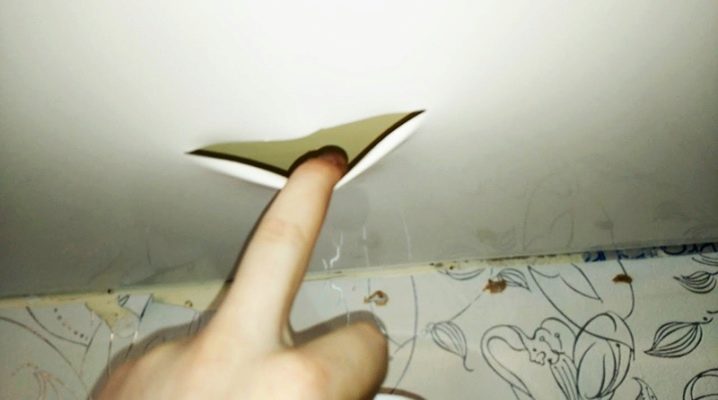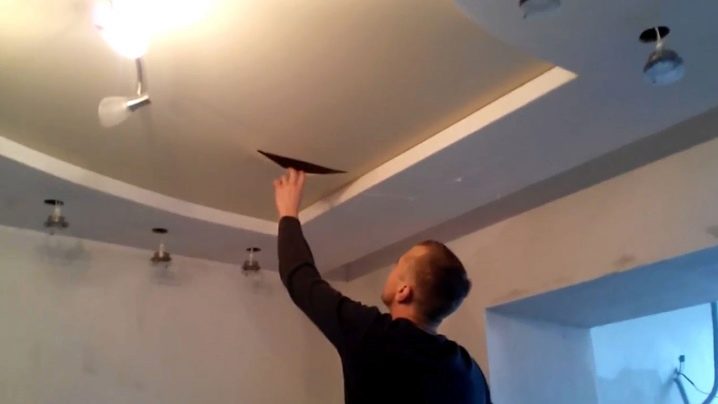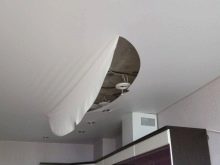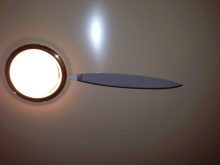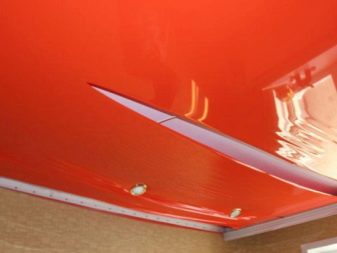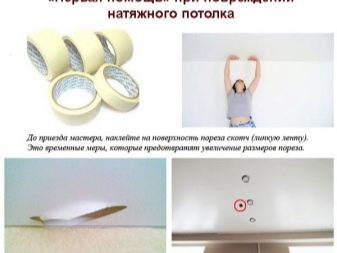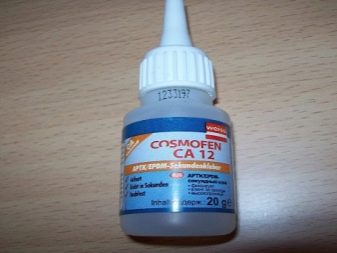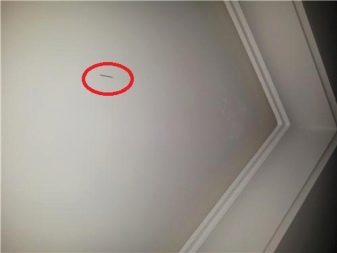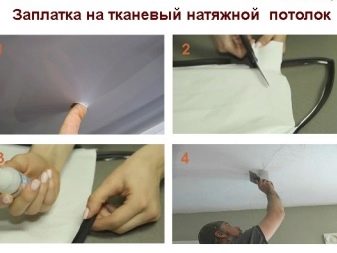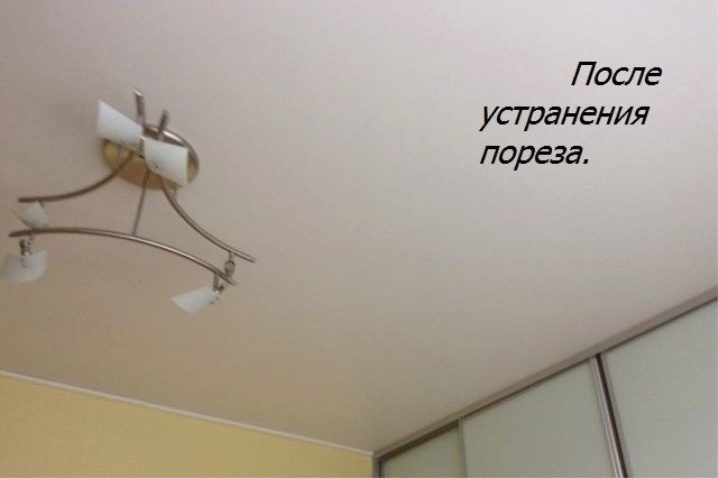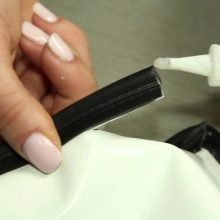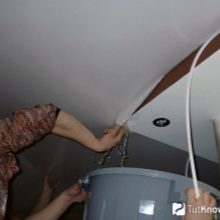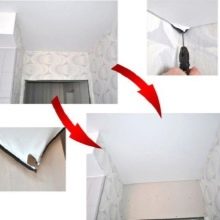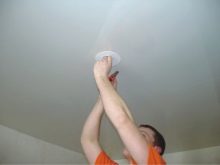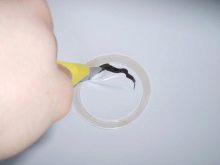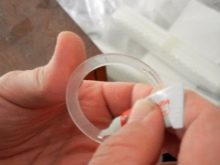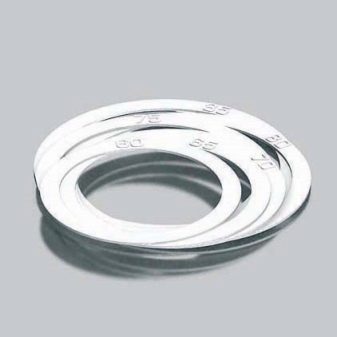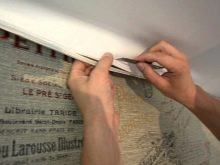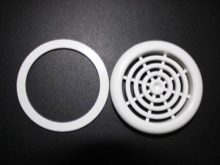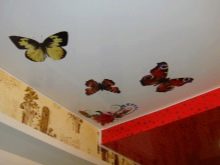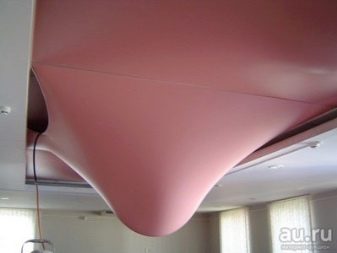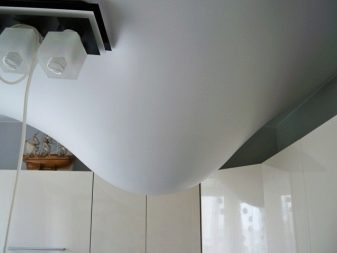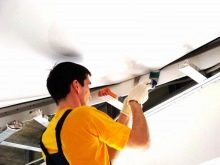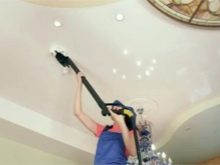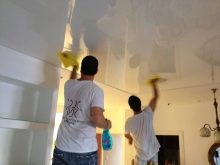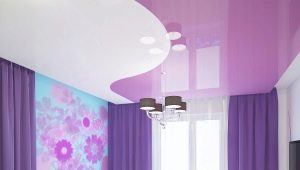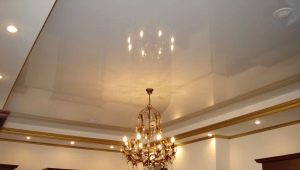Repair of stretch ceilings after a cut
Often, the happy owners of stretch ceilings decorate them with all sorts of decorative elements. But sometimes they forget that the ceiling material has a certain margin of safety. You need to know how to fix it if it breaks.
Causes of damage
Tensioning cloths are designed as follows - a metal frame on which the canvas is stretched. With this design, an empty layer remains between the ceiling and the fabric, due to which the fabric becomes vulnerable from the outside as well as from the inside.
The material of the cloth can withstand a large load under tension, but with point effects it has low strength.
Common causes of mechanical damage to the fabric include:
- Damage to toys or other objects during the games of little pranksters. Especially dangerous are flying remote-controlled toys.
- Graze when installing tall furniture with sharp corners.
- Large differences in air temperature in the room (relevant for film ceiling).
- Damage with a sharp object, such as tools, which results in a cut or puncture.
- Errors in the process of cutting the canvas or when installing the ceiling.
Especially careful to handle the ceiling immediately after installation. This is due to the fact that during this period the canvas has a high tension.
It is also possible to damage the surface by making a mistake when installing the built-in lamps and, in case of inaccurate movement, with sparks from Bengal lights or another source of fire. In this case, the ceiling will be the easiest to glue.
In what cases repair is prohibited?
There are two cases in the event of which the repair of the stretch ceiling is prohibited.
First, you should not try to repair the cloth, if it sprawled at the seams. In this case, the situation will be saved only by re-tensioning the ceiling fabric by a specialist.
Also, do not take up the repair, when the canvas moved away from the wall. In this, as in the previous case, it is necessary to reinstall the ceiling by a team of specialists: strengthening or replacing the profile and tension of the fabric.Additionally, it is necessary to determine the cause of the incident: the cloth was poorly fixed, or, conversely, the canvas was too tightly stretched. Determining the cause will help professionals to quickly carry out the necessary repairs.
Both cases are warranted, and the repair company must carry out the elimination of such damage.
How to fix the ceiling?
If the damage relates to a warranty case (the warranty period has not yet expired and the gap occurred without your participation), you should call the specialists from the company that installed the ceiling, and they will repair it for you free of charge, and also give the warranty period for the work performed! Options for self-repair in case of a non-warranty case will be described further depending on the types of the ceiling.
First of all, when detecting mechanical damage to any type of ceiling Urgent measures should be taken to prevent an increase in the size of the cut. This will require a double-sided / masking tape. In the absence of such materials, ordinary scotch tape will do.
If the damage is very small (puncture), then it is repaired with glue.Glueing will not allow the web to disperse, and the damage itself will be almost imperceptible.
Next, we will tell you how to repair the ceiling yourself if it is damaged.
Fabric
Recall that the fabric ceiling is made of "breathing" natural or synthetic fibers. Mechanical damage to the fabric of the cloth are eliminated quite easily in one of two ways.
- With the help of nylon thread. Kapron threads are sold in most sewing shops, you only need to choose the right color. This method is used if the cut is thin and has smooth edges. The cut is carefully sewn with thread, and the task is completed!
To the seam was not visible, you can paint over the place of cut water-based paint.
- Using the patch. This method is advisable to apply for large damage, but with a gap length of more than 30 cm, the ceiling will have to be changed completely. The material for the patch can be a piece of the material of the ceiling itself (if available), glass fiber or, in extreme cases, a piece of dense fabric matched by color.
Any patch glue is suitable, provided it is colorless.However, experts advise to use glue based on cyanoacrylate.
The repair sequence is quite simple: a patch is cut with a margin around the edges of about 2 cm, glue is applied to the patch, and then this patch is pressed against the damaged panel from the inside. Press too hard, it can have consequences in the form of sagging of a ceiling in the place of repair.
Excess glue is removed, and after drying, the place is treated with water-based paint from the spray gun.
Film
The canvas for such a ceiling is made of polyvinyl chloride (PVC), due to which it has a smooth glossy or matte surface.
In case of mechanical damage to PVC fabric larger than 2 cm, it is necessary to contact the specialists, who will most likely advise to replace it completely.
If the cut is small, you can try to repair it yourself.
The method of repair depends on the location:
- Hiding a cut in the groove of a baguette. Can be used if the distance from the cut to the edge of the baguette does not exceed 15 cm. You will need a length of antenna cable and glue. The cable is glued next to the cut parallel to the baguette.While glue hardens, the building hair dryer prepares for use. Then the cut is heated with a hairdryer, and gently pulled to the edge of the baguette with a cable. The cable is tucked into the groove of the baguette with a flat and blunt tool.
Working in pairs is likely to help avoid the occurrence of folds and irregularities. Otherwise, the folds formed in the process are eliminated in a similar way with a cable.
- Patch. This case is suitable if the cut is located far from the edges of the baguette. It is better to make a patch of the remnants of the film from the repair kit, which is usually attached to the stretch ceiling, and spread it with a sealant or glue. Scotch tape laid on the cut area is removed and a patch is placed in its place. While it dries, it is better to additionally fix it with your hands.
There are some nuances of choosing a glue for the patch. It should be transparent and harden quickly, without exerting a devastating effect on the PVC canvas. Masters recommend using Cosmophen glue.
You can also use any other adhesive designed to repair suspended ceilings.
For a piece of film for the patch, you can contact the manufacturer: they usually have a large number of scraps, and getting the required size will not be a problem.
In addition to the usual patch, there is an option to make an unusual decorative on a damaged ceiling. Particularly interesting will look like a patch, made in the style of wallpaper.
- Installation of functional elements on the damaged place. In place of the cut, you can install an additional lamp, a deceptive grille of the ventilation channel or a fire alarm sensor. But first, the cut should be protected from spreading with a special plastic ring. When the area is protected, you can begin the installation of the lamp or grating.
This method is usually used in offices and public places, but it is also applicable to the bathroom or toilet.
- Masking with a patch or appliqué. Damage around the chandelier in the presence of fantasy is masked by a decorative element that not only eliminates the hassle of replacing the ceiling, but also updates the room. If you play with the shape and color, you can get a great design move.
- It is possible to hide traces of flashing or burning with a special ring. from heat-resistant plastic, which is installed around the lamp. However, with a length of damage of more than 20 cm, the blade must be replaced.
Useful recommendations
With a large defect size will have to call the masters to reinstall the ceiling. But on the cost of the baguette in this case, you can still save. Do not attempt to repair a large defect yourself - this can lead to dire consequences.
And in any case, if there are doubts in their skills, you need to turn to professionals. The manufacturer will give advice on how best to repair the damage, or perform repairs on their own in a short time and with a guarantee, and will also help in case of need to provide material for the patch (especially if the ceiling is colored).
It also narrows the choice of action when cutting the ceiling, which has jagged edges. Wherein after sealing the cut on the sides you need to make its edges even. Then there are a couple of options - masking with a lamp / grate or any object of choice, or a colored decorative inset.
Fabric ceiling is resistant to mechanical damage, but will not save when flooded. Small cuts of fabric canvass are quite easily removed by themselves. Due to the indicated properties fabric ceiling is not recommended for installation in bathrooms. If the family has small children and / or domestic animals (cat, birds) in residential premises, it is better to install the ceiling on a fabric basis.
PVC ceiling can withstand flooding, but with mechanical damage to fix it will be problematic. Therefore, it is advised to install it in the bathroom or in the kitchen, where the probability of flooding is higher than in other parts of the apartment.
To reduce the possibility of damage, you should not put a film ceiling in the nurseries and living rooms. Note that, according to statistics, PVC ceilings are installed more often.
On the glossy PVC canvas all damages that were repaired without changing the canvas will be much more noticeable in the future than on the matte one.
And remember - compliance with the rules of operation of the stretch ceiling will reduce to a minimum the probability of violating its integrity, and it will please the eye for a long time! With careful handling stretch ceiling will last at least 30 years.
Below are the basic rules, observing which, you can avoid repair of the stretch ceiling in the future:
- install a suspended ceiling at the final stage of repair;
- do not install a suspended ceiling in the country, in a sauna and other rooms that may not be heated;
- Built-in lights should be up to 40 watts;
- clean the ceiling panel carefully, for example, with a damp sponge or suede, use non-acetone non-abrasive products;
- when cleaning or working with a stretch ceiling, remove jewelry and watches from your hand;
- Do not press on the ceiling panel.
Any damage to the ceiling can be easily repaired if you follow these tips.
See the next video for the repair of the stretch ceiling cut.
